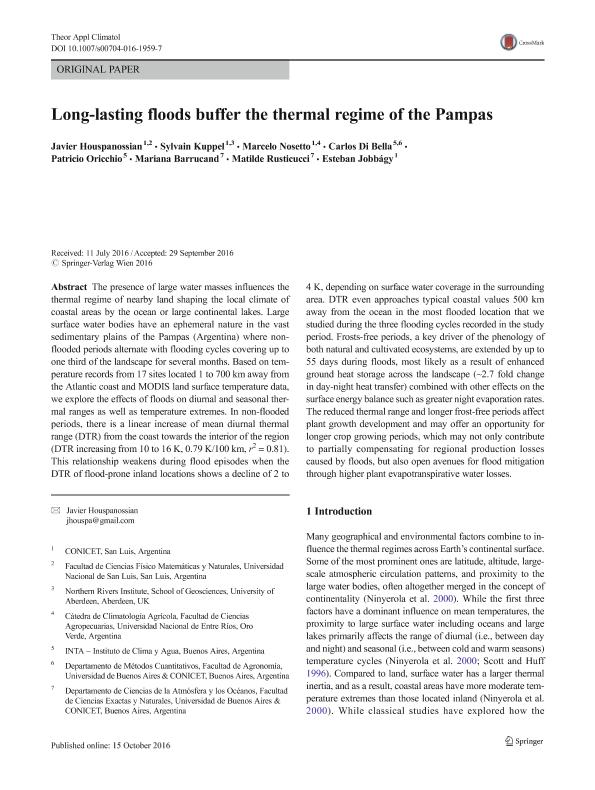Mostrar el registro sencillo del ítem
dc.contributor.author
Houspanossian, Javier

dc.contributor.author
Kuppel, Sylvain

dc.contributor.author
Nosetto, Marcelo Daniel

dc.contributor.author
Di Bella, Carlos Marcelo

dc.contributor.author
Oricchio, Patricio
dc.contributor.author
Barrucand, Mariana Graciela

dc.contributor.author
Rusticucci, Matilde Monica

dc.contributor.author
Jobbagy Gampel, Esteban Gabriel

dc.date.available
2018-08-16T16:55:54Z
dc.date.issued
2018-01
dc.identifier.citation
Houspanossian, Javier; Kuppel, Sylvain; Nosetto, Marcelo Daniel; Di Bella, Carlos Marcelo; Oricchio, Patricio; et al.; Long-lasting floods buffer the thermal regime of the Pampas; Springer Wien; Theory & Application Climatology; 131; 1-2; 1-2018; 111-120
dc.identifier.issn
0177-798X
dc.identifier.uri
http://hdl.handle.net/11336/55917
dc.description.abstract
The presence of large water masses influences the thermal regime of nearby land shaping the local climate of coastal areas by the ocean or large continental lakes. Large surface water bodies have an ephemeral nature in the vast sedimentary plains of the Pampas (Argentina) where non-flooded periods alternate with flooding cycles covering up to one third of the landscape for several months. Based on temperature records from 17 sites located 1 to 700 km away from the Atlantic coast and MODIS land surface temperature data, we explore the effects of floods on diurnal and seasonal thermal ranges as well as temperature extremes. In non-flooded periods, there is a linear increase of mean diurnal thermal range (DTR) from the coast towards the interior of the region (DTR increasing from 10 to 16 K, 0.79 K/100 km, r2 = 0.81). This relationship weakens during flood episodes when the DTR of flood-prone inland locations shows a decline of 2 to 4 K, depending on surface water coverage in the surrounding area. DTR even approaches typical coastal values 500 km away from the ocean in the most flooded location that we studied during the three flooding cycles recorded in the study period. Frosts-free periods, a key driver of the phenology of both natural and cultivated ecosystems, are extended by up to 55 days during floods, most likely as a result of enhanced ground heat storage across the landscape (~2.7 fold change in day-night heat transfer) combined with other effects on the surface energy balance such as greater night evaporation rates. The reduced thermal range and longer frost-free periods affect plant growth development and may offer an opportunity for longer crop growing periods, which may not only contribute to partially compensating for regional production losses caused by floods, but also open avenues for flood mitigation through higher plant evapotranspirative water losses.
dc.format
application/pdf
dc.language.iso
eng
dc.publisher
Springer Wien

dc.rights
info:eu-repo/semantics/openAccess
dc.rights.uri
https://creativecommons.org/licenses/by-nc-sa/2.5/ar/
dc.subject
Floods
dc.subject
Local Climate
dc.subject
Frost-Free Period
dc.subject
Agriculture
dc.subject
Air Temperature
dc.subject.classification
Meteorología y Ciencias Atmosféricas

dc.subject.classification
Ciencias de la Tierra y relacionadas con el Medio Ambiente

dc.subject.classification
CIENCIAS NATURALES Y EXACTAS

dc.subject.classification
Agricultura

dc.subject.classification
Agricultura, Silvicultura y Pesca

dc.subject.classification
CIENCIAS AGRÍCOLAS

dc.title
Long-lasting floods buffer the thermal regime of the Pampas
dc.type
info:eu-repo/semantics/article
dc.type
info:ar-repo/semantics/artículo
dc.type
info:eu-repo/semantics/publishedVersion
dc.date.updated
2018-08-15T14:22:22Z
dc.journal.volume
131
dc.journal.number
1-2
dc.journal.pagination
111-120
dc.journal.pais
Austria

dc.journal.ciudad
Viena
dc.description.fil
Fil: Houspanossian, Javier. Consejo Nacional de Investigaciones Científicas y Técnicas; Argentina. Universidad Nacional de San Luis. Facultad de Ciencias Físico- Matemáticas y Naturales; Argentina
dc.description.fil
Fil: Kuppel, Sylvain. Consejo Nacional de Investigaciones Científicas y Técnicas; Argentina. University of Aberdeen; Reino Unido
dc.description.fil
Fil: Nosetto, Marcelo Daniel. Consejo Nacional de Investigaciones Científicas y Técnicas; Argentina. Universidad Nacional de Entre Ríos. Facultad de Ciencias Agropecuarias; Argentina
dc.description.fil
Fil: Di Bella, Carlos Marcelo. Consejo Nacional de Investigaciones Científicas y Técnicas; Argentina. Instituto Nacional de Tecnología Agropecuaria. Centro de Investigación de Recursos Naturales. Instituto de Clima y Agua; Argentina. Universidad de Buenos Aires. Facultad de Agronomía. Departamento de Métodos Cuantitativos y Sistemas de Información; Argentina
dc.description.fil
Fil: Oricchio, Patricio. Instituto Nacional de Tecnología Agropecuaria. Centro de Investigación de Recursos Naturales. Instituto de Clima y Agua; Argentina
dc.description.fil
Fil: Barrucand, Mariana Graciela. Consejo Nacional de Investigaciones Científicas y Técnicas; Argentina. Universidad de Buenos Aires. Facultad de Ciencias Exactas y Naturales. Departamento de Ciencias de la Atmósfera y los Océanos; Argentina
dc.description.fil
Fil: Rusticucci, Matilde Monica. Consejo Nacional de Investigaciones Científicas y Técnicas; Argentina. Universidad de Buenos Aires. Facultad de Ciencias Exactas y Naturales. Departamento de Ciencias de la Atmósfera y los Océanos; Argentina
dc.description.fil
Fil: Jobbagy Gampel, Esteban Gabriel. Consejo Nacional de Investigaciones Científicas y Técnicas; Argentina
dc.journal.title
Theory & Application Climatology

dc.relation.alternativeid
info:eu-repo/semantics/altIdentifier/doi/https://dx.doi.org/10.1007/s00704-016-1959-7
dc.relation.alternativeid
info:eu-repo/semantics/altIdentifier/url/https://link.springer.com/article/10.1007%2Fs00704-016-1959-7
Archivos asociados
